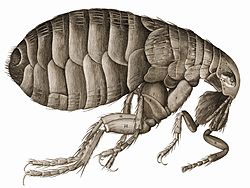蚤
Translingual
Han character
蚤 (Kangxi radical 142, 虫+4, 10 strokes, cangjie input 水戈中一戈 (EILMI), four-corner 17136, composition ⿱㕚虫(TJKV) or ⿱叉虫(G))
Derived characters
References
- Kangxi Dictionary: page 1078, character 20
- Dai Kanwa Jiten: character 32893
- Dae Jaweon: page 1547, character 19
- Hanyu Da Zidian (first edition): volume 4, page 2836, character 3
- Unihan data for U+86A4
Chinese
| trad. | 蚤 | |
|---|---|---|
| simp. # | 蚤 | |
Glyph origin
| Historical forms of the character 蚤 | ||
|---|---|---|
| Warring States | Shuowen Jiezi (compiled in Han) | Liushutong (compiled in Ming) |
| Chu slip and silk script | Small seal script | Transcribed ancient scripts |

|

|

|
Ideogrammic compound (會意/会意) : 虫 (“insect”) + 㕚 (“claw”) – a scratching insect/pest.
Pronunciation
- Mandarin
- (Standard Chinese)+
- Hanyu Pinyin:
- Zhuyin: ㄗㄠˇ
- Tongyong Pinyin: zǎo
- Wade–Giles: tsao3
- Yale: dzǎu
- Gwoyeu Romatzyh: tzao
- Palladius: цзао (czao)
- Sinological IPA (key): /t͡sɑʊ̯²¹⁴/
- (Standard Chinese)+
- Cantonese
- (Standard Cantonese, Guangzhou–Hong Kong)
- Jyutping: zou2
- Yale: jóu
- Cantonese Pinyin: dzou2
- Guangdong Romanization: zou2
- Sinological IPA (key): /t͡sou̯³⁵/
- (Standard Cantonese, Guangzhou–Hong Kong)
- Southern Min
- Middle Chinese: tsawX
- Old Chinese
- (Baxter–Sagart): /*tsˤuʔ/
- (Zhengzhang): /*ʔsuːʔ/
Definitions
- flea
- † (deprecated template usage) Alternative form of 早.
Synonyms
Compounds
Lua error in Module:zh/templates at line 27: This template has been deprecated. Please use Template:col3 instead.
Japanese
Kanji
Readings
Etymology

| Kanji in this term |
|---|
| 蚤 |
| のみ Hyōgai |
| kun'yomi |
Possibly derived from 飲み (nomi), the nominalized 連用形 (ren'yōkei, “continuative or stem form”) of verb 飲む (nomu, “to drink”), from the way that fleas drink the host's blood.
Pronunciation
Lua error in Module:parameters at line 858: Parameter "yomi" is not used by this template.
Noun
- a flea (parasitic insect)
Usage notes
As with many terms that name organisms, this term is often spelled in katakana, especially in biological contexts (where katakana is customary), as ノミ.
Derived terms
- 蚤の市 (nomi no ichi): a flea market
Idioms
References
Korean
Hanja
蚤 • (jo) (hangeul 조, revised jo, McCune–Reischauer cho, Yale co)
- This term needs a translation to English. Please help out and add a translation, then remove the text
{{rfdef}}.
Okinawan
Kanji
Etymology
Cognate with Japanese 蚤 (nomi).
Pronunciation
Noun
Vietnamese
Han character
(deprecated template usage) 蚤 (tao)
- This term needs a translation to English. Please help out and add a translation, then remove the text
{{rfdef}}.
- Translingual lemmas
- Translingual symbols
- Han script characters
- Han ideogrammic compounds
- Chinese lemmas
- Mandarin lemmas
- Cantonese lemmas
- Hokkien lemmas
- Teochew lemmas
- Middle Chinese lemmas
- Old Chinese lemmas
- Chinese hanzi
- Mandarin hanzi
- Cantonese hanzi
- Hokkien hanzi
- Teochew hanzi
- Middle Chinese hanzi
- Old Chinese hanzi
- Chinese nouns
- Mandarin nouns
- Cantonese nouns
- Hokkien nouns
- Teochew nouns
- Middle Chinese nouns
- Old Chinese nouns
- Chinese terms with IPA pronunciation
- Chinese terms spelled with 蚤
- Chinese terms with obsolete senses
- Japanese kanji
- Japanese hyōgai kanji
- Japanese kanji with goon reading そう
- Japanese kanji with kan'on reading そう
- Japanese kanji with kun reading のみ
- Japanese kanji with kun reading はやい
- Japanese terms spelled with 蚤 read as のみ
- Japanese terms read with kun'yomi
- Japanese lemmas
- Japanese nouns
- Japanese terms spelled with hyōgai kanji
- Japanese terms with 1 kanji
- Japanese terms spelled with 蚤
- Japanese single-kanji terms
- ja:Fleas
- ja:Parasites
- Korean lemmas
- Korean hanja
- Okinawan lemmas
- Okinawan Han characters
- Okinawan terms with IPA pronunciation
- Okinawan nouns
- ryu:Fleas
- ryu:Parasites
- Vietnamese lemmas
- Vietnamese Han characters
